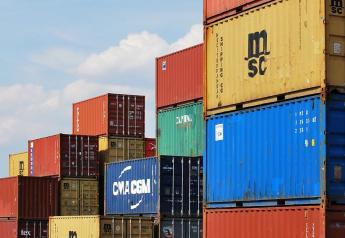First Thing Today: Consultant Holds Brazilian Crop Pegs Steady after Good Rains

Good morning!
Followthrough selling in grains, light short-covering in beans... Corn futures are fractionally lower after a quiet overnight session. Soybean futures are 1 to 2 cents higher amid some light short-covering. Winter wheat futures are steady to 3 cents lower, while spring wheat is mixed. The U.S. dollar index is under light pressure, as are crude oil futures.
PF CCI: Kansas leads HRW wheat crop rating lower... When USDA's latest crop condition ratings are plugged into the weighted Pro Farmer Crop Condition Index (0 to 500 point scale, with 500 being perfect), the HRW wheat crop fell 4.26 points to 340.76 points, with Kansas leading the decline as warm temperatures and disappointing precip last week took a toll on the crop. The SRW wheat crop inched just 0.27 points lower to 376.89 points. Get more details.
Consultant holds Brazil crop estimates steady after good rains... Last week's rainfall in central Brazil was "probably the best thus far this growing season and there is more rain in the forecast," reports South American Crop Consultant Dr. Michael Cordonnier, who adds that northeast areas of the country also enjoyed good rains. Therefore, he left his bean crop estimate unchanged at 107 MMT with a neutral bias going forward. AgRural reports 57% of the 2017-18 Brazilian bean crop had been planted as of Thursday, six points behind year-ago. Cordonnier also made no change to his Brazilian corn crop estimate that stands at 88 MMT. He had a neutral bias toward that crop, too. While planting of the full-season corn crop is near complete in southern areas of the country, planting lags in south-central Brazil. He also notes that Conab is likely too optimistic on the safrinha corn crop, detailing that the Mato Grosso Institute of Agricultural Economics is calling for a 10.4% decline in safrinha acreage from 2016-17.
No change to Cordonnier's Argentine estimates, but dryness a concern in some areas... Cordonnier also left his Argentine soybean and corn crop estimates unchanged at 55 MMT and 42 MMT, with a neutral bias going forward. He details that 12% of the soybean crop has been planted, according to the Buenos Aires Grain Exchange, which is in line with year-ago. Thirty-five percent of the corn crop has been seeded, which lags the norm and average slightly. He says areas of Cordoba are getting dry and with just light showers for Cordoba, parts of Santa Fe and northern Buenos Aires expected near-term, this warrants monitoring. "Another week or two of dry weather, and it would start to be a concern," he elaborates.
French farm office trims soft wheat crop peg... France's farm ministry today trimmed its soft wheat crop estimate by 400,000 MT from month-ago, pegging the crop at 37.5 MMT. Nevertheless, this would still be up a dramatic 36.1% from last year's weather-stricken crop. It would also be the country's third largest wheat crop on record.
Commerce's Ross blasts Japan for beef duties... Sharp criticism of Japan for their auto trade surplus with the U.S. and steep tariffs on imports of U.S. beef came Monday from Commerce Secretary Wilbur Ross. "Japan and other Asian countries routinely espouse free trade rhetoric but actually are far more protectionist than the U.S.," Ross told the U.S./Japan Council. "In the case of Japan there are some high tariffs, such as the 50% present tariff on U.S. beef versus 22.5% on Australian beef." Plus, he chided Japan and others for non-tariff barriers on autos like varying standards, inspection systems and tightly held distribution channels.
Minerva: Asian markets to bring in up to half of the world's beef in the next few years... Demand for beef is on the rise in China. Therefore, the beef processor Minerva SA says it expects Asia to become the destination for up to half of the world's beef in the next three to four years. Currently, it accounts for 46% of the global market.
Tyson plans to up chicken slaughter capacity with new facility, but running into opposition... U.S. chicken consumption will likely hit a record high this year, according to the National Chicken Council. Looking to capitalize on this, Tyson Foods Inc. is trying to decide on a new site for its first new chicken plant since the 1990s that would boost its overall production capacity by processing 1.25 million birds per week. The $320-million plant would include a slaughterhouse, a chicken hatchery and feed mill. The project was planned for Tonganoxie, Kansas, but it has run into roadblocks as residents are concerned about the facility's environmental impact and other issues. This has delayed its planned autumn groundbreaking and has Tyson on the hunt for other sites.
Cattle futures trading below respective cash markets... Cattle futures faced light pressure to start the week, as traders awaited more signals as to this week's cash prospects. Last week, cash sales took place at an average price of $122.71, according to USDA. This is roughly $2 above where the December live cattle contract finished yesterday, which should limit pressure on the market. Feeder cattle are also trading at a discount to their cash index.
Holiday pork buying fades... Ongoing weakness in the cash hog market limited buying interest in lean hog futures to start the week, but traders were also hesitant to push prices lower given futures' discount to the cash hog index. These factors could lead to more sideways action near-term. Also of note, just 249.91 loads of pork changed hands yesterday on a 50-cent drop in the pork cutout value. Recent slow movement may signal holiday buying is winding down.
Overnight demand news... Bangladesh issued an international tender to buy 50,000 MT of milling wheat from optional origins, with the exception of Israel. Japan tendered to buy a total of 125,611 MT of food-quality wheat from the U.S., Canada and Australia. South Korea issued an international tender to buy around 55,000 MT of optional origin corn.
Today's reports:
- 1:00 p.m., Oil Crops Outlook: November 2017 -- ERS
- 2:00 p.m., Feed Outlook: November 2017 -- ERS
- 2:00 p.m., Wheat Outlook: November 2017 -- ERS







